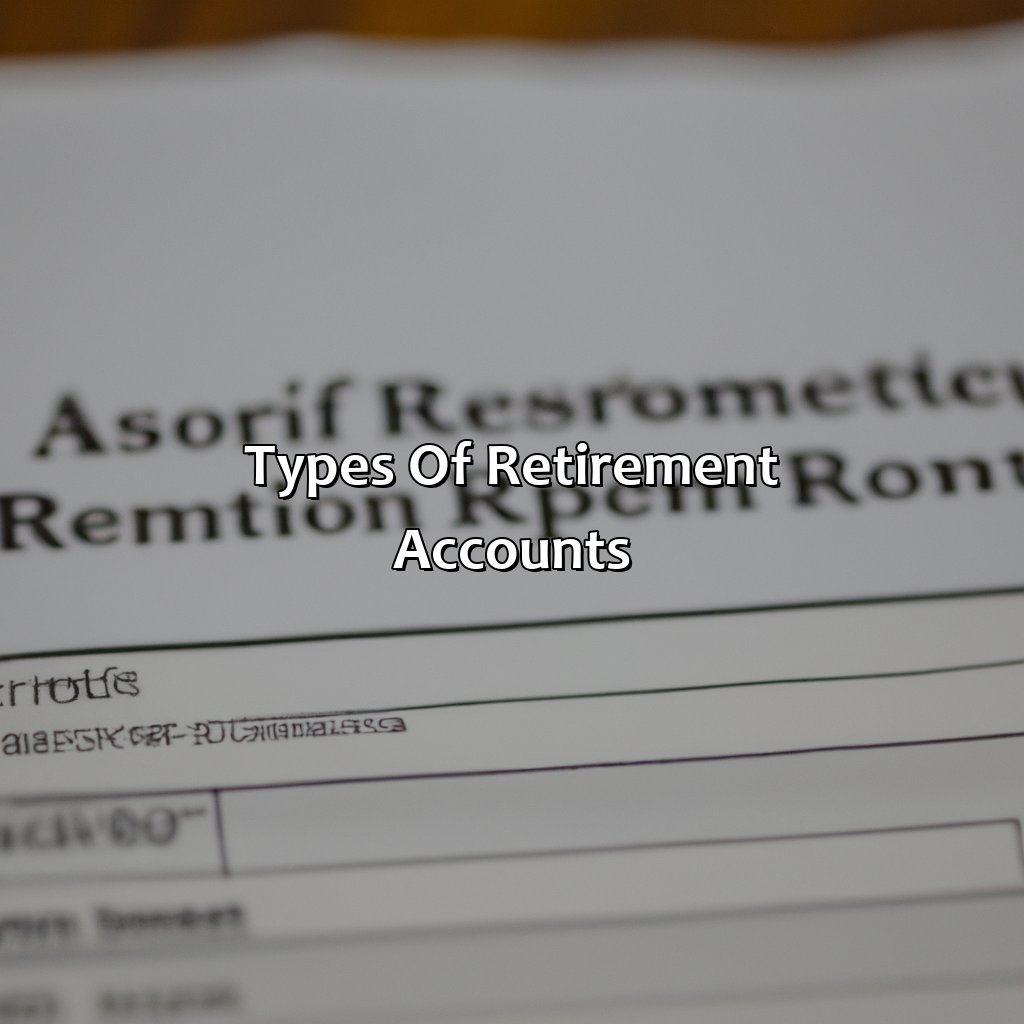How To Open A Retirement Account?
Key Takeaway:
- Understanding Retirement Accounts: It’s important to have a clear understanding of retirement accounts before deciding which one to open. Doing research on the various types of retirement accounts, their benefits, and their fees is crucial for making an informed decision.
- Types of Retirement Accounts: There are several types of retirement accounts, including traditional IRAs, Roth IRAs, 401(k) plans, SEP plans, and SIMPLE IRAs. Each has its own advantages and disadvantages, and choosing the right one depends on factors like income, age, and retirement goals.
- How to Open a Retirement Account: Once you’ve decided on the type of retirement account that’s right for you, the process of opening one involves researching different providers, filling out the application, setting up contributions, and choosing investments. Managing your retirement account requires monitoring your investments, adjusting your portfolio as needed, and staying on track to reach your retirement goals.
You don’t want to reach retirement age unprepared. Planning for retirement is essential and it starts by opening a retirement account. In this article, you’ll learn exactly how to open a retirement account and get your retirement savings on track.
Understanding Retirement Accounts
Understanding Retirement Accounts:
To understand retirement accounts, first, identify which type suits your retirement goals – IRA, Roth IRA, 401(k), or brokerage account. Retirement accounts offer tax advantages and compound interest. Contributions and withdrawals have rules and penalties.
Ensure you meet the minimum criteria to avoid penalties for early withdrawal or non-contribution. Follow contribution maximums, and understand the investment options, risks and returns to optimize your retirement account benefits. Choosing the right retirement account depends on your financial situation, retirement goals, and when you want to access your income. Not all accounts offer the same tax breaks, investment options, and rules. Seek professional help if unsure.
Consider automating contributions, investing in a diverse portfolio and rebalancing it periodically. Allocate assets based on your risk tolerance and retirement goals. Consistent contributions and compounding interest work best for long-term wealth creation.

Image credits: retiregenz.com by Harry Arnold
Types of Retirement Accounts
When planning for retirement, it is crucial to understand the different options available for retirement accounts. Knowing the various types can help you choose the right account that suits your needs and future goals.
Retirement accounts come in different types and have unique features. The following table outlines some of the common types of retirement accounts with their respective advantages and disadvantages:
| Retirement Account | Description | Advantages | Disadvantages |
|---|---|---|---|
| 401(k) | Employer-sponsored | Tax-deferred contributions, employer matching, investment options | Limited investment choices, early withdrawal penalties |
| Roth IRA | Individual | Tax-free withdrawals in retirement, no required minimum distributions | Contributions not tax-deductible, income limits |
| Traditional IRA | Individual | Tax-deductible contributions, potential tax-deferred growth | Required minimum distributions, taxes on withdrawals |
| SEP IRA | Self-employed | High contribution limits, tax-deductible contributions | Employer contributions required, early withdrawal penalties |
| Simple IRA | Small business owners | Easy to set up and administer, employer matching | Limited contribution limits |
It is important to note that some retirement accounts, such as the 401(k), may have limits on contributions and investment options. Moreover, depending on your financial situation and goals, certain accounts may be more suitable than others.
Sarah, a freelance writer, decided to open a Roth IRA account after consulting with a financial advisor. She wanted a retirement account that allows tax-free withdrawals in retirement and has no required minimum distributions. The decision paid off, and she was able to retire comfortably without worrying about taxes on her retirement income.

Image credits: retiregenz.com by Yuval Duncun
How to Open a Retirement Account
Opening a Retirement Account: A Professional Guide
Retirement planning is crucial for securing your future, and opening a retirement account is the first step towards it. Here’s how to do it:
- Choose the Right Account: IRA, Roth IRA, 401(k), or a combination of these. Understanding each type of account and their respective tax implications is crucial.
- Choose a Financial Institution: Banks, investment firms, and credit unions offer retirement accounts. Compare fees, investment options and customer service before opening an account.
- Complete the Paperwork: Once you’ve selected the account and the institution, complete the required paperwork and submit it along with the initial deposit.
A critical aspect of retirement account planning is to keep track of contributions, manage investments, and update beneficiaries. Seek advice from a professional to ensure better returns and financial security.
Pro Tip: Start planning early and increase contributions as you progress in your career. The earlier you start, the more time your investment has to grow.

Image credits: retiregenz.com by Adam Arnold
Managing Your Retirement Account
Managing Your Retirement Account
Investing in a retirement account is a prudent way to secure your financial future. By investing in IRAs (Individual Retirement Accounts), Roth IRAs, 401(k)s, and other retirement accounts, you can secure your retirement years. Through wise management of your retirement account, you can achieve the desired income stream during your golden years. By monitoring performance and adjusting as necessary, you can stay on track towards achieving long-term financial goals.
To manage your retirement account effectively, it is essential that you keep up with the markets, economy, and any risks associated with your investment portfolio. Monitor your account regularly and track its performance against benchmarks and targets. Diversification of investments within the account is critical to achieving the desired risk and return profile. And, if you are unsure of investment options, seek professional guidance to avoid making uninformed decisions.
Remember that managing your retirement account does not necessarily mean checking on it frequently or making drastic changes. You should always be aware of how it is performing, but it is equally imperative that you stay true to the broader, long-term plan. Patience and discipline are essential when it comes to retirement account management.
Pro Tip: Take advantage of automatic contributions as they can provide regular savings discipline and dollar-cost averaging, which is a smart way to optimize your investments.

Image credits: retiregenz.com by Yuval Woodhock
Some Facts About How To Open A Retirement Account:
- ✅ The most common types of retirement accounts are 401(k)s and IRAs. (Source: Investopedia)
- ✅ Contributions to retirement accounts are tax-deferred, meaning you do not pay taxes on the money until you withdraw it. (Source: The Balance)
- ✅ Some employers offer matching contributions to 401(k) plans, meaning they will match a percentage of your contribution. (Source: NerdWallet)
- ✅ There are limits to how much you can contribute to a retirement account each year, depending on your age and the type of account. (Source: IRS)
- ✅ It is important to choose investments that align with your risk tolerance and retirement goals when opening a retirement account. (Source: CNBC)
FAQs about How To Open A Retirement Account?
How do I open a retirement account?
To open a retirement account, you will need to choose the type of account you want to open, such as a traditional IRA or a Roth IRA, find a financial institution that offers that type of account, fill out an application, and fund the account.
What type of retirement account should I open?
The best type of retirement account for you depends on your financial situation, retirement goals, and personal preferences. Some common types of retirement accounts include traditional IRAs, Roth IRAs, 401(k) plans, and SEP IRAs. Consider speaking with a financial advisor to determine which type of account is right for you.
What documents do I need to open a retirement account?
The documents required to open a retirement account vary depending on the financial institution and type of account. Generally, you will need to provide your name, address, social security number, and information about your employment and income. Some institutions may also require proof of identity and citizenship.
How much money do I need to open a retirement account?
The amount of money you need to open a retirement account varies depending on the type of account and financial institution. Some accounts may require a minimum deposit, while others do not. Consider researching different institutions and accounts to find one that fits your budget.
What are the tax implications of opening a retirement account?
The tax implications of opening a retirement account depend on the type of account you choose. Traditional IRAs offer tax-deductible contributions and tax-deferred growth, while Roth IRAs offer tax-free withdrawals in retirement. Consult with a tax professional for personalized advice on your specific tax situation.
Can I contribute to a retirement account if I already have a 401(k) through my employer?
Yes, you can still contribute to a retirement account even if you have a 401(k) through your employer. Consider opening an IRA or a SEP IRA to supplement your employer-sponsored plan and increase your retirement savings.






